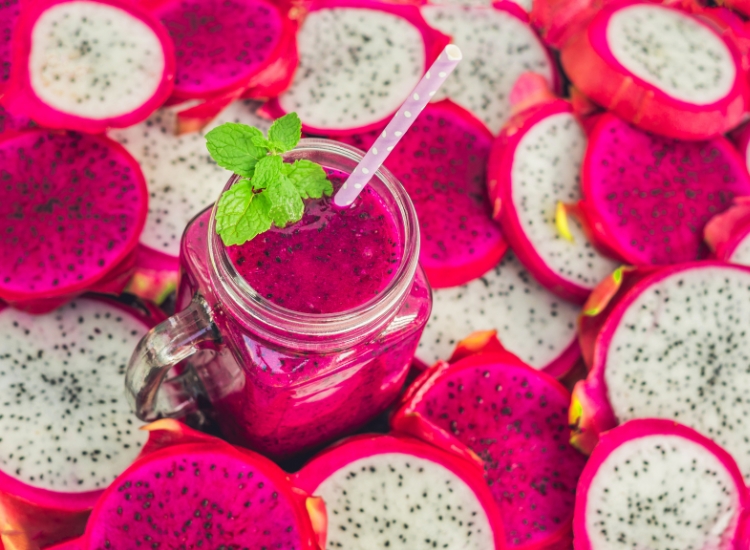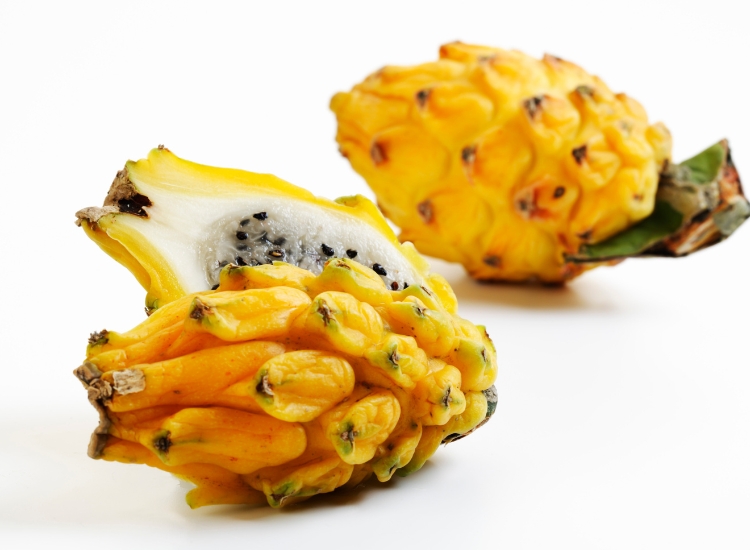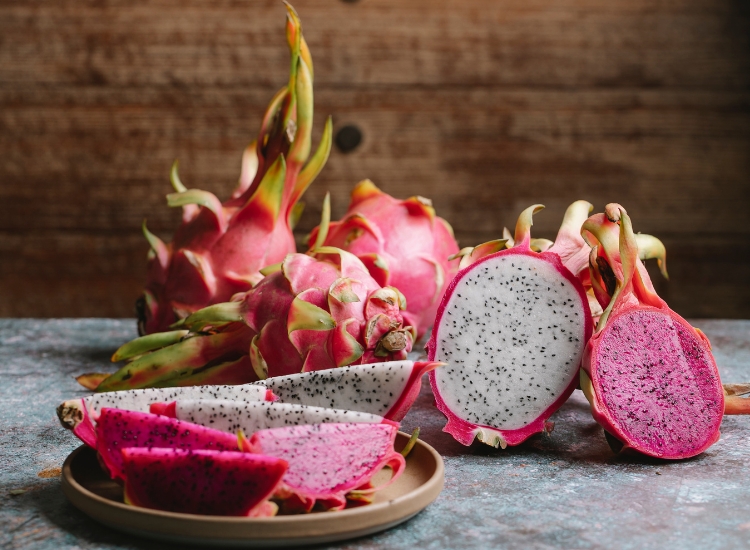Dragon fruit, also known as pitaya, is visually stunning with its bright hues and packed with multiple nutrients. This fantastic fruit offers a range of health benefits that can address various health conditions. If you have already incorporated this colorful and delicious fruit into your daily diet alongside other nutritious fruits and vegetables, you are on the right track to maintaining excellent health.
Dragon fruit is gaining immense popularity among health enthusiasts and fruit lovers. It is named, and unique shape might remind you of the fire-breathing creatures from folklore or the beloved Harry Potter series. With its scaly appearance, dragon fruit is indeed a hidden jewel.
We highly recommend tasting this fruit if you have yet to try it. In the following paragraphs, we will discuss how to eat dragon fruit and explore its numerous health benefits. But before we delve into that, let’s briefly discuss the characteristics of this vibrant fruit.
1. What is dragon fruit?
Dragon fruit grows on a climbing cactus called Hylocereus in tropical regions worldwide. Its name is derived from the Greek word “hyle,” which means “woody,” and the Latin word “cereus,” which means “waxen.”
The fruit has a hot pink or yellow bulb-like appearance with spike-like green leaves resembling flames. When you cut it open, you’ll discover fleshy white flesh filled with edible black seeds.

There are red and yellow-skinned varieties of this fruit. It originally grew in southern Mexico and South and Central America. The French introduced it to Southeast Asia in the early 19th century.
In Central America, it is known as “pitaya,” while in Asia, it is referred to as a “strawberry pear.” Nowadays, dragon fruit can be purchased throughout the U.S.
Dragon fruit is juicy and sweet, often described as a combination of kiwi, pear, and watermelon. The seeds have a nutty flavor.
2. Dragon Fruit Varieties
Keep an eye out for the four main varieties of dragon fruit:
- Pink skin with white flesh (Hylocereus undatus): This is the most common variety and has the least sweet taste. It may be sold under names such as Alice, Cosmic Charlie, David Bowie, Guyute, Harpua, L.A. Woman, Neitzel, Seoul Kitchen, Thomson, and Vietnamese Jaina.
- Pink skin with red or pink flesh (Hylocereus polarizes): This variety is more extended and sweeter than white flesh. You might find it labeled Bloody Mary, Red Jaina, Voodoo Child, or Zamorano.
- Pink skin with purple flesh (Hylocereus guatemalensis): This stunning variety is also sold as “American Beauty.”
- Yellow skin with white flesh (Selenicereus megalanthus): This is the smallest and sweetest variety among the bunch. It may be a bit harder to find, but it’s worth seeking out.

3. Nutritional value of dragon fruit
The nutritional value of dragon fruit contains many valuable nutrients for the body. It is a source of essential dietary fiber, iron, and magnesium.
According to research, about 100 grams of dragon fruit provides the following nutrients:
- Calories: 60 grams
- Carbohydrates: 13 grams
- Protein: 1.2 grams
- Dietary fiber: 3 grams
- Fat: 0 grams
- Magnesium: 10% of Recommended Daily Intake (RDI)
- Iron: 4% of RDI
- Vitamin C: 3% of RDI
With abundant magnesium and dietary fiber content and meager calories, dragon fruit is considered a nutritionally rich fruit that offers various benefits for overall health to consumers.
Consuming dragon fruit daily helps supplement important antioxidants, protecting the body’s cells from unstable molecules and preventing certain risks of chronic diseases and aging.
Some critical antioxidants found in dragon fruit’s flesh include:
Flavonoids: This diverse group of antioxidants enhances brain health and reduces the risk of heart disease. Hydroxycinnamates: These antioxidants have demonstrated activity against cancer. Betalains: Predominantly present in the red flesh of dragon fruit. These deep red pigments protect the body’s LDL “bad” cholesterol from damage or oxidation.
Incorporating dragon fruit into your diet can provide these valuable antioxidants and improve your overall well-being.
4. Health Benefits of Dragon Fruit
Now that we know some interesting facts about dragon fruit, let’s discuss the ten dragon fruit advantages for health and wellness.
Supports Gut Health
- Dragon fruit has excellent prebiotic properties that promote gut health.
- It can improve inflammatory bowel disease (IBD) symptoms and reduce the risks of digestive tract infections, diarrhea, and colon cancer.
- Including dragon fruit in your diet helps improve the balance of healthy bacteria in the digestive system.
Boosts Immune System
- Dragon fruit is a rich source of vitamin C and carotenoids that strengthen the immune system.
- It protects white blood cells from damage caused by free radicals, thus preventing infections.
- Consuming dragon fruit daily can help maintain a healthier immune system.
Boosts Low Iron Levels
- Dragon fruit contains iron, which helps combat low iron levels in the body.
- It is vital in transporting oxygen to cells, tissues, and organs.
- The presence of vitamin C in dragon fruit enhances iron absorption.
Fights Chronic Diseases
- Dragon fruit fights against chronic diseases such as diabetes, heart disease, cancer, and arthritis.
- Its antioxidants neutralize free radicals, preventing cell damage and inflammation.
- Betalains in dragon fruit help reduce bad cholesterol.
Reduces the Risk of Diabetes
- Dragon fruit helps maintain stable blood sugar levels due to its high fiber content.
- It is recommended for diabetic individuals to control and prevent spikes in sugar levels.
Fights Skin Aging
- The antioxidants in dragon fruit treat skin issues like dryness, acne, and sunburn.
- Vitamin C helps fight skin damage caused by free radicals, leading to brighter and healthier skin.
Great for Hair
- Dragon fruit’s nutritional value promotes hair growth and improves its texture.
- The iron content in dragon fruit assists in carrying oxygen to the hair roots.
Supports Eye Health
- Beta-carotene in dragon fruit prevents eye problems like macular degeneration and cataracts.
- Consuming dragon fruit daily can help maintain good eye health.
Builds Stronger Bones
- Dragon fruit contains magnesium, which plays a role in building stronger bones.
- Including dragon fruit in your diet helps maintain good bone health.
Good for Pregnant Mothers
- Dragon fruit benefits pregnant mothers as it promotes proper fetal brain development.
- It contains folate, iron, and vitamin B, which provide energy and help prevent congenital disabilities.
- Magnesium in dragon fruit helps combat postmenopausal complications in women.
5. What does dragon fruit taste like?
If you have never had this fruit, you might wonder, “How does dragon fruit taste?” Well, it has a combined taste of a kiwi and a pear. It has a refreshing, refined, and subtle flavor. When ripe, the fruit has a mildly sweet taste, and its soft texture is similar to the flesh of a ripe kiwi.
If you enjoy eating the refreshing fruit, kiwi, you will also like the flavor of dragon fruit. However, under-ripe dragon fruit may seem tasteless. The taste can also vary depending on the type of dragon fruit you consume. The white or yellow-skinned pitaya varieties may have milder flavors than the reddish or darker-pink varieties.

The fruit is known for its unique vivid and leathery outer skin texture. When you cut the fruit for the first time, you will be pleasantly surprised by the fresh white pulp filled with tiny black seeds. The seeds themselves have a nutty flavor and are rich in healthy fats.
The best time to eat dragon fruit is in the morning during breakfast. Consuming it in the morning helps the digestive system break down the fruit sugar faster. However, you can also enjoy this superfruit with your midday meal or as part of your dinner at night.
6. How to Prepare Dragon Fruit
Before purchasing dragon fruit, gently squeeze it. It should give a little without feeling too soft or mushy. Avoid fruits with bruises or dry leaves, as these are signs of overripeness. If the fruit feels hard when pressed, allow it to ripen on the counter for a few days before consuming.
To prepare the fruit, cut it into quarters. You can peel the skin away or remove the flesh with a spoon, ice cream scoop, or melon baller. Remember not to eat the skin.
7. How to Eat Dragon Fruit
There are several ways to enjoy dragon fruit:
- Toss it into a fruit salad, combining it with other tropical fruits like pineapple and mango.
- Create a salsa by cutting it into small pieces.
- Churn it into delicious ice cream.
- Squeeze it to extract juice or add it to water for a refreshing drink.
- Use it as a topping for Greek yogurt.
- Freeze it and blend it into a smoothie.
8. How to Store Dragon Fruit
Store any leftover dragon fruit in a plastic bag in the refrigerator for up to 5 days. Alternatively, you can freeze it for up to 3 months.
Frequently Asked Questions
What does dragon fruit taste like?
Dragon fruit is often described as having a flavor profile that combines pear and kiwi with hints of citrus. It has a mild sweetness, and its flesh is tender and quickly scooped with a spoon.
Can you eat dragon fruit daily?
Absolutely! Dragon fruit is an excellent source of vitamin C and other antioxidants, making it a healthy addition to your daily diet. However, it’s important to note that dragon fruit is high in fiber. Fiber-rich foods, including dragon fruit, may cause gas, bloating, or cramping. Moderation is key.
Which color of dragon fruit has more health benefits?
The pink dragon fruit with red flesh contains higher levels of betalains, beneficial plant pigments. Betalains have been associated with reducing harmful cholesterol levels.

